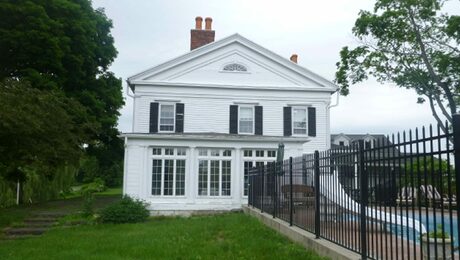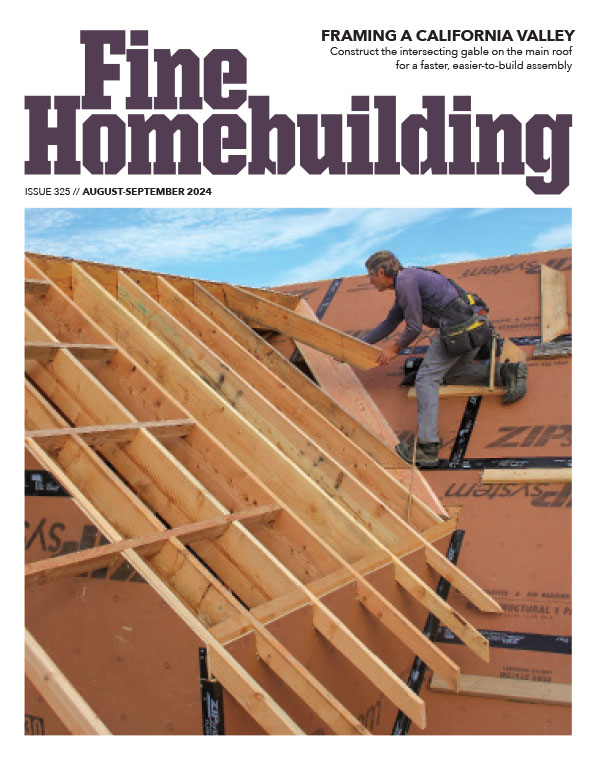I have to install kitchen wall cabinets by myself to steel studs that are not 16″ oc. I was thinking maybe a French cleat system would be a good way to handle the lack of uniformity in stud spacing. Any thoughts or experience would be greatly appreciated!
Discussion Forum
Discussion Forum
Up Next
Video Shorts
Featured Story

Listeners write in about attics, foundations, and dodgy electrical devices. They ask questions about trusses, wet ceilings and siding installs.
Featured Video
Video: Build a Fireplace, Brick by BrickHighlights
"I have learned so much thanks to the searchable articles on the FHB website. I can confidently say that I expect to be a life-long subscriber." - M.K.














Replies
You would need to know where the steel studs are to hang the french cleat.
Seems like this just moves the problem.
Locating the studs has been pretty straightforward and reliable using a magnet. The problem is it's an old condo and the studs aren't uniform, leaving some cabinets with insufficient fasteners. I was hoping someone had some experience hanging kitchen cabinets with the cleats and fill in the gaps for me regarding details like whether I should let in the back of the carcass to tighten the cabinets up flush or just add backer board behind the backsplash, etc.
Yes, I have hung numerous plumbing display boards along with showroom cabs with French cleats.
In most cases the cleats are inset on the back panel so the sides end up flush with the walls. Regular store bought cabs could be ordered with extended end panels to finish a run.
The beauty of the system is by short running the wall cleats a bit, it gives you some side to side adjustment before finish.
First, what gauge are the metal studs? Lighter gauge metal (less than 20) I would use Hilti Togglers to fasten the cleats. With the wings set vertical into the stud, this gives you a maximum load bearing connection.
With lighter gauge studs, I might also think about wood blocking between studs. Is this a common wall with another unit?
Not sure of the gauge, it's a 40 year old unit and appears to be 20 gauge. They held up concrete board very well in the bathrooms. It is a common wall, and I was considering cutting a 6" to 10" strip out of the drywall and replacing with 5/8 higher grade plywood.
Reference insetting the cleats onto cabinet backs I was thinking if I use a metal cleat system like the Monarch Z-clips I could get away with just furring the back of the cabinets out with plywood because the clips would only push the cabinets out about 1/4" or so and I could add a strip to the wall to keep cabinets plumb. The backsplash should cover the reveal no problem.
Common wall could mean fire separation, which protects both party’s.
One way to leave it so you don’t compromise the sepation by installing the ply would be to still add your ply over the sheetrock and do a pilaster of wood or drywall ar each end of the cab run. If your base and uppers line up at each end. Build out the splash to flush with the pilasters and it should look decent. The build out wouldn’t need to be deep like a wing wall. Or, cap the splash on each end with a slightly less build out.
Edit: Still thinking. You don’t want to lose counter depth, so don’t build out the splash.
But then again, I’m in Ohio. Not exactly the birthplace of design.
.
losing 3/4" of counter may still be a good compromise. it maintains the firebreak and also sound break. it's a galley kitchen so really the built up backsplash will not be visible as both ends terminate in a wall.
thanks to all for advice
Don’t forget to bring back some pictures!
Too many times we don’t see the end result.
Are you also screwing the cabinets to each other?
My kitchen cabinets are hung with such a system (modeled on IKEAs, as this is how all of their kitchens are built--I thought it was a cool idea, so used it when remodeling my own kitchen a few years ago. I realize IKEA is, well, IKEA, but it might be worth taking a look at how their system works, if you're looking for more info about hanging cabinets this way. They also sell their "cleats" as separate pieces). One reason I did this was the same as yours: my studs are not uniform, and some of them in the interior wall are as far apart as 26" (and then a few were much closer together; I don't know what happened during the building of this house, sigh). I screwed my cleats into every stud and at least every 12-14", and used heavy-duty toggle bolts for the screws without studs--I know the studs themselves are doing all the work, but I like the extra security.
It worked well for me. My cabinets still have legs (purchased from the place where I had the doors made: Scherr's Custom Cabinets, a great company that did beautiful work for me) or 2x4 frames, for balance and extra support behind the toekicks, but you could certainly do without those and just have floating cabinets. My cabinets are screwed together, as well. I didn't bother furring out the backs of the cabinets throughout; I simply used end panels to cover the reveal on the sides, and made the cabinets less deep to compensate. I screwed the cabinet cleats into the sidewalls of the cabinet and into a 1x4 across or up the back, as well, for extra security, and used some metal corner braces/right angles as reinforcement, too. (Some might think it's overkill, but I wanted to make sure they were extra sturdy.)
Since my wall cleat was one long strip, I could adjust the entire row side to side very easily to make sure they were in exactly the right spot--just slide them along, basically, and then insert the legs underneath. That was nice. The cabinets are very sturdy; I cook and bake a lot, and have lots of cast-iron cookware--hence the metal angles etc.--and the cabinets haven't sunk or shifted or anything (I've also stood on them a number of times, when tiling the wall/refinishing the ceiling/building shelving above them. I am a 5'1 lady who weighs about 105 soaking wet, but still). I also like knowing that if I ever want to remodel again, or build different cabinets, removing the current ones will be easy.
So personally, I highly recommend such a system. It worked really well for me--so well, in fact, that I've used it throughout the rest of the house for dressers/shelving units/beds.
I hope that helps!
FWIW Magnets also work well on wood studs. Find the drywall screws. Just an extra check on those stud finders that sometimes leave you scratching your head.
I am a commercial casework installer, ranging from wood kitchen cabinets to phenolic resin laboratory grade casework (HEAVY). The majority of our uppers are attached with a cleat system. Honestly they just don't feel secure otherwise. We are always screwing to metal studs, 2 screws per stud, just don't over drive the screws and strip the metal (Other solution is strap toggles, but probably over kill). We always use some form of adhesive as a back up. GE 1000 series silicone or liquid nails.
Can you share some images?